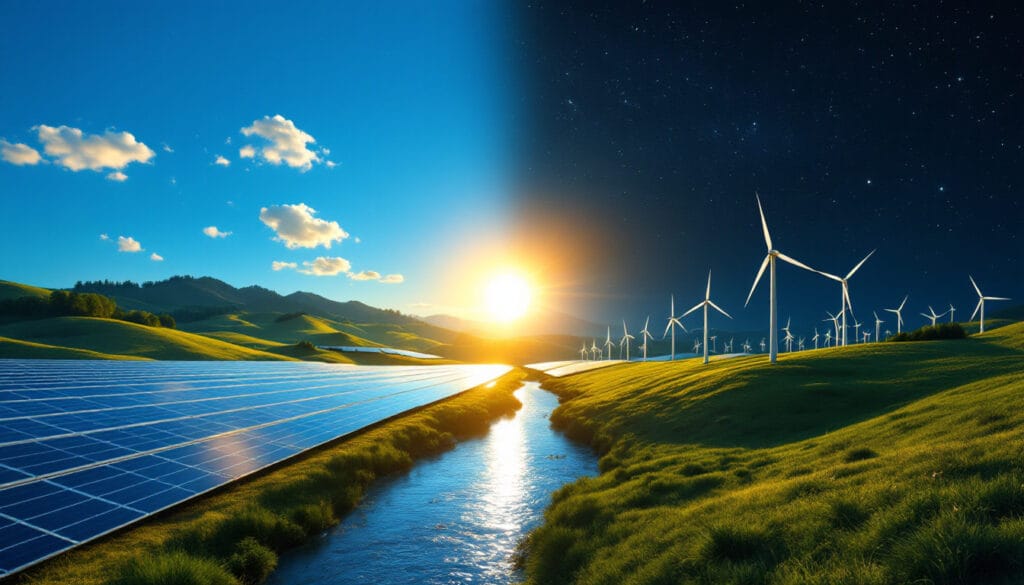Components of the Energy Balance
The energy balance is a crucial tool for analyzing energy consumption and identifying ways to reduce it. It measures the amount of energy used by a system or organization, as well as the sources of that energy. Understanding the different components of the energy balance allows for better resource management and optimization of energy efficiency.
The main components of an energy balance include:
- Primary energy consumption: This category encompasses unprocessed natural energies, such as oil, natural gas, coal, and solar energy.
- Final energy consumption: This represents the energy actually used by consumers, i.e., after transformation and distribution of primary energy.
- Renewable energies: These include all renewable energy sources like wind, solar, hydro, and biomass. These energies are crucial for sustainable development.
- Grey energy: Refers to the energy consumed indirectly during the production, transportation, installation, and recycling of products.
A comprehensive energy balance also examines energy losses at each stage of the production and use chain. The main causes of energy losses are:
- Conversion losses: Energy lost during the transformation of one form of energy to another, such as during electricity production from fossil fuels.
- Transport losses: Energy lost during the transportation and distribution of energy, mainly due to material resistance and distance traveled.
- Storage losses: Energy lost when it is stored, for example, in batteries or thermal storage tanks.
- Usage losses: Energy loss during final use, for example, in the form of heat unnecessarily dissipated by household appliances.
Effective management of the energy balance involves identifying and reducing these losses. The adoption of new technologies, improvement of conversion processes, and increased use of renewable energies are key strategies to optimize this balance and decrease the ecological footprint.
Energy Sources
The energy balance is an essential tool for understanding the consumption and production of energy in a given system. It measures the balance between energy input and energy output, contributing to identifying areas for improvement in terms of energy efficiency and sustainability.
The energy balance is divided into several components, each playing a crucial role in the overall analysis.
- Incoming energy: This refers to all forms of energy introduced into the system, such as electricity, natural gas, or fossil fuels.
- Outgoing energy: This part represents energy losses and consumption for various applications, such as heating, lighting, and household appliances.
- Stored energy: Here, we consider the energy stored in devices such as batteries or thermal storage tanks.
- Energy losses: Losses must be accounted for, whether due to appliance efficiency, heat leaks, or losses in the distribution network.
Understanding the different energy sources is vital in developing an effective energy balance.
- Renewable energies: These sources include solar, wind, hydro, geothermal, and biomass energy. They are essential for reducing carbon footprints and promoting sustainable development.
- Fossil energies: Despite their environmental impact, oil, coal, and natural gas remain common sources of energy. It is crucial to use them more efficiently.
- Nuclear energy: Significantly contributing to electricity production, this source requires stringent management of waste and associated risks.
- Grey energy: This is the energy consumed during the life cycle of products, from production to disposal. Less visible, it is nevertheless important to consider.
A detailed energy balance helps to better understand current energy use and plan necessary actions for a more efficient and environmentally respectful management.
Energy Consumption
The energy balance is an essential element for assessing energy consumption and efficiency in various sectors. It encompasses a multitude of data allowing the measurement of energy flows entering and leaving a system. For those looking to optimize their resources and reduce their environmental footprint, understanding the components of the energy balance is crucial.
An energy balance consists primarily of several key elements. These elements provide an overview of the energy sources used, their transformation within the system, and their final consumption. The main components are:
- Primary energy sources such as fossil fuels, nuclear, and renewable energies.
- Energy conversion processes that transform primary sources into secondary or final energy, such as electricity or heat.
- Intermediate consumptions that occur during the transformation and transportation of energy.
- Final consumptions in residential, commercial, industrial, and transportation sectors.
Energy consumption can be analyzed by distinguishing the different sectors that use energy. Each sector has specific needs and particular characteristics:
- Residential: Encompassing domestic uses such as heating, cooking, and lighting.
- Commercial: Including offices, stores, and services.
- Industrial: Comprising factories and manufacturing processes.
- Transport: Covering road vehicles, airplanes, and ships.
To manage energy consumption effectively, it is vital to implement optimization strategies. This can include integrating sensors, using efficient conversion technologies, and promoting bioenergy and fuel cells. By understanding these aspects, one can not only reduce energy costs but also limit environmental impact.
Articles similaires
Thank you!
We will contact you soon.













